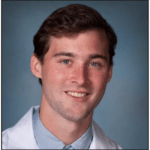This column is a monthly feature of “Health & Exercise Forum” in association with the students and faculty of Geisinger Commonwealth School of Medicine (formerly The Commonwealth Medical College).
GCSOM Guest Author: Brendan Bormes, MD3

Brendan Bormes, MD3 graduated from GCSOM in May of 2019 and is presently a first year resident in Anesthesiology at Georgetown University Medical Center. A native of Clarks Summit and graduate of Scranton Preparatory School, he majored in biology and music at Bucknell University and received a masters degree in physiology and biophysics from Georgetown University.
It’s that time of year…after a long winter of nights that come early and last too long there is LIGHT at the end of the tunnel! In the fall and winter, especially this far north, many people start to feel the gloom of their surroundings creep into their psyche and spring cannot arrive too soon...Is this normal, or a sign of something more serious?
Seasonal affective disorder, or SAD, is at the far end of a spectrum of seasonal mood changes. The mildest of these, “seasonality”, is a normal response to cyclical changes in weather and light exposure. However, when symptoms like depressed mood, lack of motivation, or a shift to more vegetative daily habits become severe and debilitating, SAD may be the cause. In fact, one study found that SAD affects up to 10% of primary-care patients, and that those with a previous diagnosis of depression are even more at risk. Fortunately, though, there are well established therapies that can help those afflicted with SAD to get through the dark winter months. The American Psychiatric Association defines SAD as a subtype of either Major Depressive Disorder or Bipolar Disorder, depending on the symptoms. It can consist of episodes that onset during either fall/winter or spring/summer, or have symptoms characteristic of either “major depressive” or “manic” episodes. The vast majority of those with SAD, however, experience a persistent overall depressed mood during the shorter days of fall and winter.
In more serious cases:
If enough of these symptoms are present for a long enough time and onset in a seasonal pattern, that can mean Seasonal Affective Disorder. Most people with the disorder find themselves sleeping more and eating more (especially carbs), and report that their symptoms can even resolve with relocation to a sunnier environment. Along the spectrum of disease is a less severe form called “subsyndromal” SAD, which can still be effectively treated. Periods of SAD tend to resolve with the coming of spring, but they can be immensely distressing and always deserve medical intervention.
No one knows exactly why Seasonal Affective Disorder happens, but it appears to be associated with decreased exposure to natural light during the fall and winter months. One possible explanation is the “phase-shift” hypothesis. It states that your body’s circadian rhythms, which are regulated by hormones and the brain, become out-of-step with environmental sleep/wake cues as the days shorten. In other words, the light levels around you and your body’s internal clock are telling you two different things about when to sleep. This disruption of circadian rhythms, or “phase-delay”, likely contributes to the symptoms of SAD, although precisely how it induces changes in mood remains unclear. Another hypothesis for the mechanism underlying SAD involves abnormalities in the activity of serotonin, a neurotransmitter in the brain. Normally, serotonin regulates mood and attention. However, studies have found that people with SAD clear serotonin out of their brains faster, giving the hormone less of a chance to provide a boost in mood.
Current medical treatment of SAD targets the changes in both circadian rhythms and serotonin metabolism. This can be accomplished with light therapy, antidepressant medications or a combination of both.
Visit your doctor regularly and listen to your body.
Read Dr. Mackarey’s "Health & Exercise Forum" every Monday in the Scranton Times-Tribune.
This article is not intended as a substitute for medical treatment. If you have questions related to your medical condition, please contact your family physician. For further inquires related to this topic email: drpmackarey@msn.com
Paul J. Mackarey PT, DHSc, OCS is a Doctor in Health Sciences specializing in orthopaedic and sports physical therapy. Dr. Mackarey is in private practice and is an associate professor of clinical medicine at Geisinger Commonwealth School of Medicine.